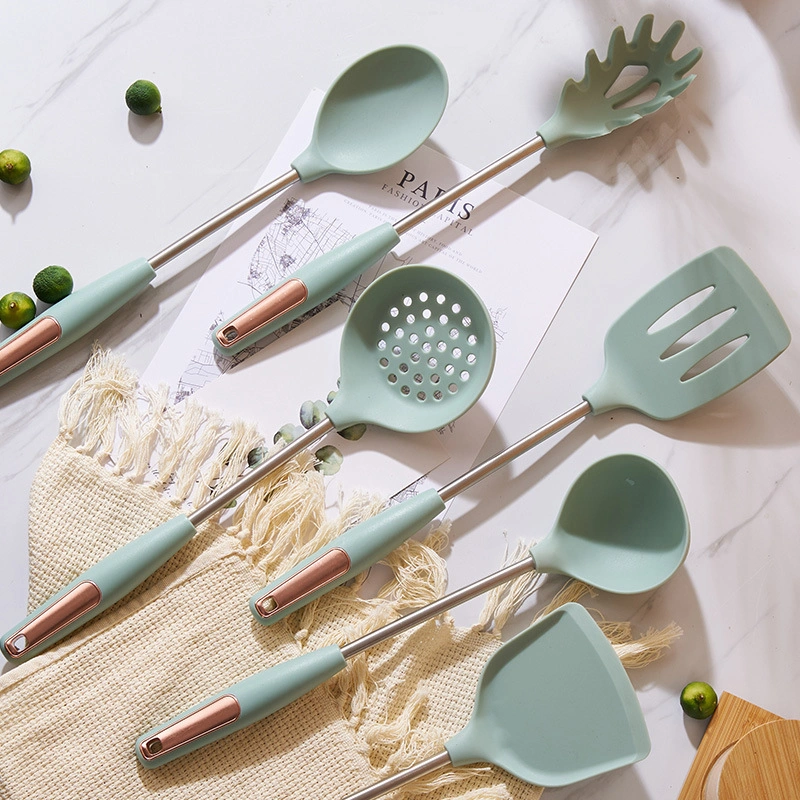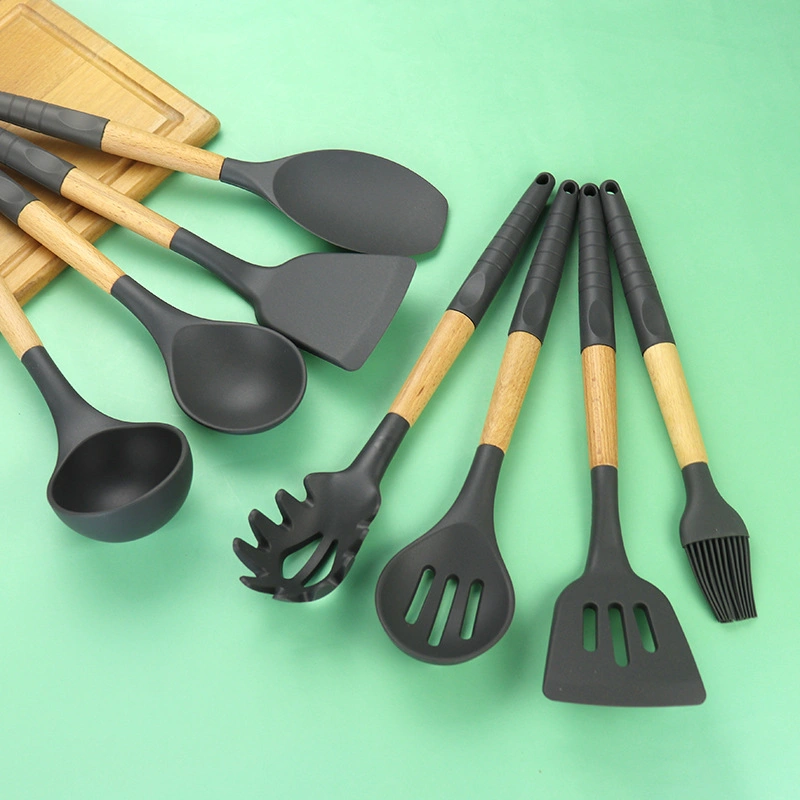Custom Silicone Cooking Utensils Factory
Food-Grade Silicone for Kitchen Utensils Making
Silicone has become a popular material for making kitchen utensils due to its durability, flexibility, and heat resistance. When it comes to choosing the right type of silicone for kitchen utensils making, it is important to consider the quality and safety of the material. Food-grade silicone is the most commonly used type of silicone for making kitchen utensils, as it is specifically designed to be safe for use with food.
Food-grade silicone is made from a combination of silicon, oxygen, carbon, and hydrogen. It is non-toxic, BPA-free, and does not leach harmful chemicals into food. This makes it a safe choice for making kitchen utensils that come into contact with food. Food-grade silicone is also heat-resistant, which means it can withstand high temperatures without melting or releasing harmful fumes.
There are different types of food-grade silicone that are used for making kitchen utensils. One common type is platinum-cured silicone, which is considered the highest quality silicone available. Platinum-cured silicone is made using platinum as a catalyst, which results in a more stable and durable material. This type of silicone is often used for making high-end kitchen utensils that require superior quality and performance.
Another type of food-grade silicone is peroxide-cured silicone, which is made using peroxide as a catalyst. While peroxide-cured silicone is still safe for use with food, it is not as high quality as platinum-cured silicone. This type of silicone is often used for making more affordable kitchen utensils that do not require the same level of durability and performance.
When choosing the right type of food-grade silicone for making kitchen utensils, it is important to consider the specific requirements of the utensil. For example, if you are making a spatula or a whisk that will be used for stirring hot foods, you will want to use a high-quality silicone that is heat-resistant and durable. On the other hand, if you are making a silicone mold for baking, you may be able to use a lower quality silicone that does not require the same level of heat resistance.
In addition to the type of silicone used, it is also important to consider the design and construction of the kitchen utensil. Food-grade silicone can be molded into a variety of shapes and sizes, making it versatile for different types of utensils. It is important to ensure that the silicone is properly molded and sealed to prevent any bacteria or food particles from getting trapped in the utensil.
Overall, food-grade silicone is the best choice for making kitchen utensils due to its safety, durability, and heat resistance. By choosing the right type of silicone and paying attention to the design and construction of the utensil, you can create high-quality kitchen utensils that are safe and effective for use with food. Whether you are making a spatula, a whisk, or a silicone mold, food-grade silicone is the ideal material for all your kitchen utensil making needs.

High-Temperature Silicone for Kitchen Utensils Making
Silicone has become a popular material for making kitchen utensils due to its durability, flexibility, and heat resistance. When it comes to choosing the right type of silicone for kitchen utensils making, high-temperature silicone is often the preferred choice. High-temperature silicone is specially formulated to withstand extreme heat, making it ideal for use in cooking and baking utensils that are exposed to high temperatures.
One of the key characteristics of high-temperature silicone is its ability to withstand temperatures up to 600 degrees Fahrenheit or higher. This makes it perfect for use in kitchen utensils such as spatulas, baking mats, and oven mitts that come into direct contact with hot surfaces. High-temperature silicone is also non-toxic and food-safe, making it a safe choice for use in food preparation.
In addition to its heat resistance, high-temperature silicone is also highly flexible and durable. This allows kitchen utensils made from high-temperature silicone to bend and flex without breaking, making them ideal for use in a variety of cooking and baking tasks. The flexibility of high-temperature silicone also makes it easy to clean, as it can be easily washed by hand or in the dishwasher without losing its shape or integrity.
Another benefit of high-temperature silicone is its non-stick properties. Kitchen utensils made from high-temperature silicone are naturally non-stick, making them ideal for use in cooking and baking tasks where food may stick to traditional utensils. This non-stick property also makes high-temperature silicone utensils easy to clean, as food residue can be easily wiped away without the need for harsh scrubbing or soaking.
When choosing high-temperature silicone for kitchen utensils making, it is important to look for silicone that is specifically labeled as high-temperature or heat-resistant. This ensures that the silicone has been specially formulated to withstand extreme heat and will not melt or degrade when exposed to high temperatures. It is also important to choose high-quality silicone from a reputable manufacturer to ensure that the utensils are safe for use in food preparation.
In conclusion, high-temperature silicone is an excellent choice for making kitchen utensils due to its heat resistance, flexibility, durability, and non-stick properties. When choosing high-temperature silicone for kitchen utensils making, it is important to look for silicone that is specifically labeled as high-temperature or heat-resistant and to choose high-quality silicone from a reputable manufacturer. By using high-temperature silicone in kitchen utensils making, you can create durable, safe, and versatile utensils that will enhance your cooking and baking experience.

Non-Toxic Silicone for Kitchen Utensils Making
Silicone has become a popular material for making kitchen utensils due to its durability, flexibility, and heat resistance. However, not all silicone is created equal, and it is important to use non-toxic silicone when making kitchen utensils that come into contact with food. There are different types of silicone that can be used for this purpose, each with its own set of properties and benefits.
One of the most common types of silicone used for making kitchen utensils is food-grade silicone. This type of silicone is specifically designed to be safe for use with food and is free from harmful chemicals such as BPA, lead, and phthalates. Food-grade silicone is also non-reactive, meaning it will not leach any harmful substances into food when used at high temperatures. This makes it an ideal choice for making spatulas, spoons, and other utensils that come into direct contact with food.
Another type of silicone that is commonly used for making kitchen utensils is platinum-cured silicone. This type of silicone is made using a platinum catalyst, which results in a higher level of purity and a more stable molecular structure. Platinum-cured silicone is also more resistant to high temperatures and is less likely to degrade over time compared to other types of silicone. This makes it a popular choice for making baking mats, oven mitts, and other utensils that are exposed to heat on a regular basis.
In addition to food-grade and platinum-cured silicone, there are also other types of silicone that can be used for making kitchen utensils. Liquid silicone, for example, is a type of silicone that can be molded into various shapes and sizes, making it ideal for creating custom utensils. Liquid silicone is also highly flexible and tear-resistant, making it a good choice for utensils that need to withstand frequent use.
When choosing silicone for making kitchen utensils, it is important to look for certifications such as FDA approval or LFGB compliance. These certifications ensure that the silicone meets strict safety and quality standards and is suitable for use with food. It is also important to consider the intended use of the utensil and choose a type of silicone that is appropriate for that purpose. For example, utensils that will be used in high-temperature environments should be made from heat-resistant silicone, while utensils that will be used with acidic foods should be made from non-reactive silicone.
Overall, non-toxic silicone is the best choice for making kitchen utensils that come into contact with food. By choosing the right type of silicone and ensuring that it meets safety and quality standards, you can create utensils that are safe, durable, and long-lasting. Whether you are making spatulas, spoons, or baking mats, non-toxic silicone is the ideal material for creating high-quality kitchen utensils that will stand the test of time.
